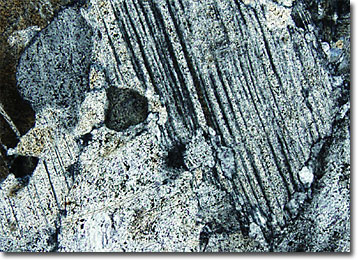Polarized Light Microscopy Digital Image Gallery
Barite
Barite is the geological name of barium sulfate, the most prevalent of the barium minerals. Though it is widely distributed around the world, some of the best-known occurrences are located in Spain, Germany, and the United States.

View a second image of Barite
Commonly colorless or white, barite may also be found in hues of reds, blues, yellows, and greens. The mineral varies in crystal habit as well, sometimes occurring in large, tubular forms, and other time in plates or concentric aggregates. In the latter instance, the crystal pattern is often likened to that of a flower, and when these formations exhibit a red tint they are often called “desert roses.” Other varieties of barite, which do not usually exhibit such a distinctive appearance, are frequently confused with other minerals, such as celestite. Indeed, similarities are so strong at times that flame tests are required to determine the true identity of the mineral.
Although barite contains the heavy metal barium, it is considered nontoxic since the mineral is very insoluble. The substance is commonly utilized for industrial purposes and is sometimes referred to as barytes commercially. The mineral is, for instance, used as an aggregate in cement, as a white pigment for paints, and as a filler material in items such as paper and cloth. It is also utilized in the processing of barium compounds and in oil and gas well drilling activities.
